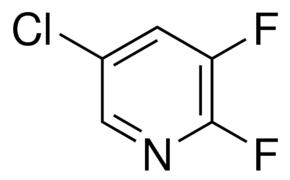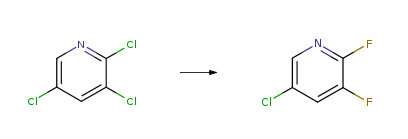2,3-Difluoro-5-chloropyridine CAS#: 89402-43-7; ChemWhat Code: 4676
Identification
| Product Name | 2,3-Difluoro-5-chloropyridine |
| IUPAC Name | 5-chloro-2,3-difluoropyridine |
| Molecular Structure |  |
| CAS Registry Number | 89402-43-7 |
| EINECS Number | 410-090-7 |
| MDL Number | MFCD04039314 |
| Synonyms | 5-chloro-2,3-difluoropyridine, 5-Chloro-2,3-difluoropyridine, 2,3-difluoro-5-chloro-pyridine, 5-chloro-2,3-difluoro-pyridine, 2,3-difluoro-5-chloropyridine, 3-chloro-5,6-difluoropyridine |
| Molecular Formula | C5H2ClF2N |
| Molecular Weight | 149.526 |
| InChI | InChI=1S/C5H2ClF2N/c6-3-1-4(7)5(8)9-2-3/h1-2H |
| InChI Key | PERMDYZFNQIKBL-UHFFFAOYSA-N |
| Canonical SMILES | c1c(cnc(c1F)F)Cl |
| Patent Information | ||
| Patent ID | Title | Publication Date |
| CN110894188 | Preparation method 2-substituted halogenated pyridine compound (by machine translation) | 2020 |
| CN104277034 | N – (aryl alkoxy) fragrant oxygen benzene oxygen carboxylic acid amide compound and its preparation method and application (by machine translation) | 2017 |
| WO2010/89210 | NOVEL HERBICIDES | 2010 |
| US5498807 | Process for the preparation of aromatic fluoro compounds | 1996 |
| US4822887 | Preparation of difluoropyridine compounds | 1989 |
Physical Data
| Appearance | Colorless and light yellow transparent liquid |
| Flash Point | 135°C |
| Refractive index | 1.4738 |
| Melting Point, °C |
| 47-49 |
| Boiling Point, °C |
| 135°C |
Spectra
| Description (NMR Spectroscopy) | Nucleus (NMR Spectroscopy) | Solvents (NMR Spectroscopy) | Temperature (NMR Spectroscopy), °C | Frequency (NMR Spectroscopy), MHz |
| 1H | chloroform-d1 | 300 | ||
| Chemical shifts | 1H | 300 | ||
| 1H | 300 | |||
| Chemical shifts | 13C |
| Description (IR Spectroscopy) | Solvent (IR Spectroscopy) |
| Bands | |
| Bands | KBr |
Route of Synthesis (ROS)
| Conditions | Yield |
| With potassium fluoride; C6H10BNO4 In dimethyl sulfoxide at 60℃; for 5h; Solvent; Temperature; Experimental Procedure 4; 8 Example 4 36.5 g of 2,3,5-trichloropyridine (0.2 mol) was added to a dry reactor.292 g of dimethyl sulfoxide, 34.8 g of potassium fluoride (0.62 mol),0.32 g of boron-containing compound I-1 (0.019 mol), and the mixture was heated to 60 ° C for 5 h.After the reaction of the raw materials is completed, the residue potassium chloride is removed by centrifugation.The mother liquid was removed under reduced pressure of the solvent dimethyl sulfoxide, and 29.5 g of 2,3-difluoro-5-chloropyridine was extracted with dichloromethane to give a qualitative content of 96%, yield 95%.The molar ratio of the fluorinated halogen to the fluorinating reagent in the raw material is 1:1.55, the molar ratio of the reactant (the material to be fluorinated) to the boron-containing compound is 1:0.1, and the weight ratio of the raw materials to the solvent other than the solvent is 1: 4. | 95% |
| With potassium fluoride; 18-crown-6 ether; potassium carbonate; cesium fluoride In sulfolane; dimethyl sulfoxide at 120 – 200℃; for 3h; Experimental Procedure 400 g of sulfolane and 400 g of dimethylsulfoxide were weighed into a 1000 mL flask and dehydrated to a temperature of less than 0.05% at 200 ° C under a pressure of 0.07 MPa (negative pressure)96 g (1.66 mol) of cesium fluoride, 96 g (1.66 mol) of potassium fluoride, 120 g (0.67 mol) of trichloropyridine, 2 g of 18-crown ether and 3 g of potassium carbonate were weighed into a reaction flask at 120 ° C and heated to 200 ° C The product was collected in about 3 hours. 95 g (0.51 mol) of the product was obtained in 90% yield. The purity was 96.8% as determined by gas chromatography. | 90% |
| With potassium carbonate; cesium fluoride In dimethyl sulfoxide | |
| With potassium carbonate In dimethyl sulfoxide | |
| With potassium carbonate; cesium fluoride In dimethyl sulfoxide |
Safety and Hazards
| Pictogram(s) |   |
| Signal | Warning |
| GHS Hazard Statements | H226: Flammable liquid and vapor [Warning Flammable liquids] H302: Harmful if swallowed [Warning Acute toxicity, oral] H412: Harmful to aquatic life with long lasting effects [Hazardous to the aquatic environment, long-term hazard] Information may vary between notifications depending on impurities, additives, and other factors. |
| Precautionary Statement Codes | P210, P233, P240, P241, P242, P243, P264, P270, P273, P280, P301+P312, P303+P361+P353, P330, P370+P378, P403+P235, and P501 (The corresponding statement to each P-code can be found at the GHS Classification page.) |
Other Data
| Transportation | Class 3; Packaging Group: III; UN Number: 1993C |
| Under the room temperature and away from light | |
| Storage | Under the room temperature and away from light |
| Market Price | USD |
| Druglikeness | |
| Lipinski rules component | |
| Molecular Weight | 149.527 |
| logP | 1.803 |
| HBA | 1 |
| HBD | 0 |
| Matching Lipinski Rules | 4 |
| Veber rules component | |
| Polar Surface Area (PSA) | 12.89 |
| Rotatable Bond (RotB) | 0 |
| Matching Veber Rules | 2 |
| Use Pattern |
| 2,3-Difluoro-5-chloropyridine CAS#: 89402-43-7 as Pesticide |
| 2,3-Difluoro-5-chloropyridine CAS#: 89402-43-7 as pharmaceutical intermediates |
| 2,3-Difluoro-5-chloropyridine CAS#: 89402-43-7 as for the synthesis of clodinafop |
Related Chemicals
Buy Reagent | |
| No reagent supplier? | Send quick inquiry to ChemWhat |
| Want to be listed here as a reagent supplier? (Paid service) | Click here to contact ChemWhat |
Approved Manufacturers | |
| Warshel Chemical Ltd | http://www.warshel.com/ |
| Want to be listed as an approved manufacturer (Requires approvement)? | Please download and fill out this form and send back to approved-manufacturers@chemwhat.com |
Contact Us for Other Help | |
| Contact us for other information or services | Click here to contact ChemWhat |


